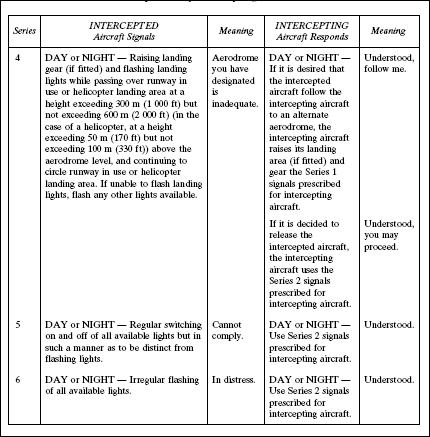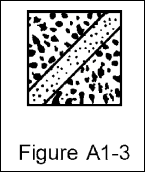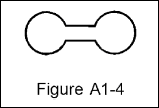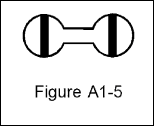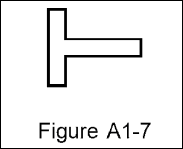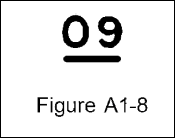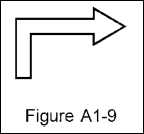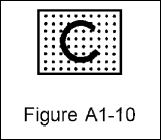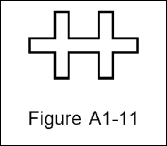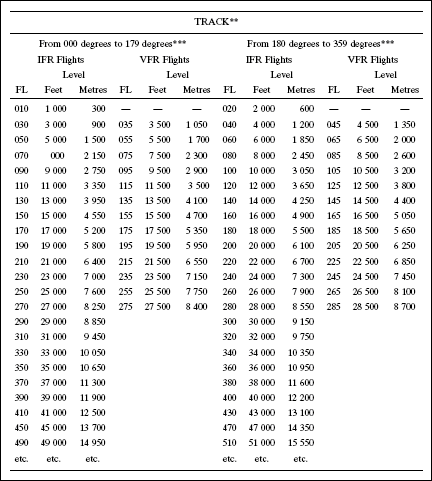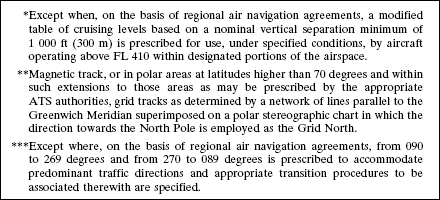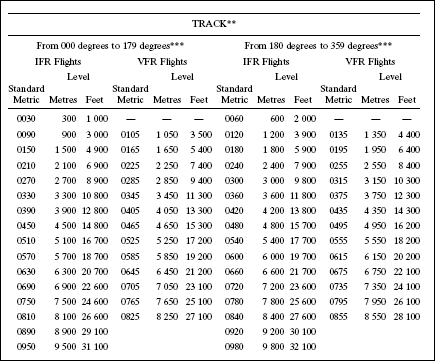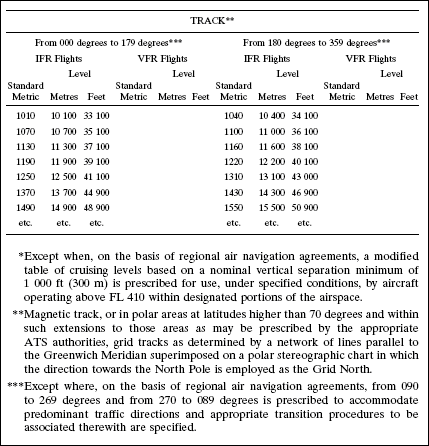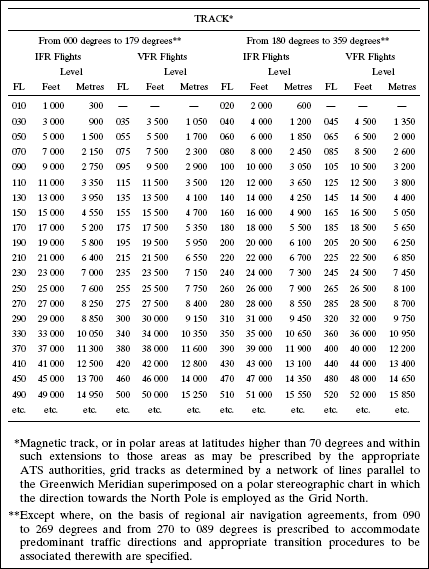28. The Eleventh Schedule to the principal Order is deleted and the following Schedule substituted therefor:| When the following terms are used in the International Standards for Rules of the Air, they have the following meanings: |
| Acrobatic flight. Manoeuvres intentionally performed by an aircraft involving an abrupt change in its attitude, an abnormal attitude, or an abnormal variation in speed. |
| ADS-C agreement. A reporting plan which establishes the conditions of ADS-C data reporting (i.e. data required by the air traffic services unit and frequency of ADS-C reports which have to be agreed to prior to using ADS-C in the provision of air traffic services). |
| Advisory airspace. An airspace of defined dimensions, or designated route, within which air traffic advisory service is available. |
| Advisory route. A designated route along which air traffic advisory service is available. |
| Aerodrome. A defined area on land or water (including any buildings, installations and equipment) intended to be used either wholly or in part for the arrival, departure and surface movement of aircraft. |
| Aerodrome control service. Air traffic control service for aerodrome traffic. |
| Aerodrome control tower. A unit established to provide air traffic control service to aerodrome traffic. |
| Aerodrome traffic. All traffic on the manoeuvring area of an aerodrome and all aircraft flying in the vicinity of an aerodrome. |
| Aerodrome traffic zone. An airspace of defined dimensions established around an aerodrome for the protection of aerodrome traffic. |
| Aeronautical Information Publication (AIP). A publication issued by or with the authority of a State and containing aeronautical information of a lasting character essential to air navigation. |
| Aeronautical station (RR S1.81). A land station in the aeronautical mobile service. In certain instances, an aeronautical station may be located, for example, on board a ship or on a platform at sea. |
| Aeroplane. A power-driven heavier-than-air aircraft, deriving its lift in flight chiefly from aerodynamic reactions on surfaces which remain fixed under given conditions of flight. |
| Airborne collision avoidance system (ACAS). An aircraft system based on secondary surveillance radar (SSR) transponder signals which operates independently of ground-based equipment to provide advice to the pilot on potential conflicting aircraft that are equipped with SSR transponders. |
| Aircraft. Any machine that can derive support in the atmosphere from the reactions of the air other than the reactions of the air against the earth’s surface. |
| Air-ground control radio station. An aeronautical telecommunication station having primary responsibility for handling communications pertaining to the operation and control of aircraft in a given area. |
| Air-taxiing. Movement of a helicopter/VTOL above the surface of an aerodrome, normally in ground effect and at a ground speed normally less than 37 km/h (20 kt). |
| Air traffic. All aircraft in flight or operating on the manoeuvring area of an aerodrome. |
| Air traffic advisory service. A service provided within advisory airspace to ensure separation, in so far as practical, between aircraft which are operating on IFR flight plans. |
| Air traffic control clearance. Authorization for an aircraft to proceed under conditions specified by an air traffic control unit. |
| Air traffic control service. A service provided for the purpose of: |
| (a) | preventing collisions:| (1) | between aircraft, and | | (2) | on the manoeuvring area between aircraft and obstructions, and |
| | (b) | expediting and maintaining an orderly flow of air traffic. |
| Air traffic control unit. A generic term meaning variously, area control centre, approach control unit or aerodrome control tower. |
| Air traffic service. A generic term meaning variously, flight information service, alerting service, air traffic advisory service, air traffic control service (area control service, approach control service or aerodrome control service). |
| Air traffic services airspaces. Airspaces of defined dimensions, alphabetically designated, within which specific types of flights may operate and for which air traffic services and rules of operation are specified. |
| Air traffic services reporting office. A unit established for the purpose of receiving reports concerning air traffic services and flight plans submitted before departure. |
| Air traffic services unit. A generic term meaning variously, air traffic control unit, flight information centre or air traffic services reporting office. |
| Airway. A control area or portion thereof established in the form of a corridor. |
| Alerting service. A service provided to notify appropriate organizations regarding aircraft in need of search and rescue aid, and assist such organizations as required. |
| Alternate aerodrome. An aerodrome to which an aircraft may proceed when it becomes either impossible or inadvisable to proceed to or to land at the aerodrome of intended landing. Alternate aerodromes include the following: |
| Take-off alternate. An alternate aerodrome at which an aircraft can land should this become necessary shortly after take-off and it is not possible to use the aerodrome of departure. |
| En-route alternate. An aerodrome at which an aircraft would be able to land after experiencing an abnormal or emergency condition while en route. |
| ETOPS en-route alternate. A suitable and appropriate alternate aerodrome at which an aeroplane would be able to land after experiencing an engine shutdown or other abnormal or emergency condition while en route in an ETOPS operation. |
| Destination alternate. An alternate aerodrome to which an aircraft may proceed should it become either impossible or inadvisable to land at the aerodrome of intended landing. |
| Altitude. The vertical distance of a level, a point or an object considered as a point, measured from mean sea level (MSL). |
| Approach control service. Air traffic control service for arriving or departing controlled flights. |
| Approach control unit. A unit established to provide air traffic control service to controlled flights arriving at, or departing from, one or more aerodromes. |
| Appropriate ATS authority. The relevant authority designated by the State responsible for providing air traffic services in the airspace concerned. |
| Regarding flight over the high seas: The relevant authority of the State of Registry. |
| Regarding flight other than over the high seas: The relevant authority of the State having sovereignty over the territory being overflown. |
| Apron. A defined area, on a land aerodrome, intended to accommodate aircraft for purposes of loading or unloading passengers, mail or cargo, fuelling, parking or maintenance. |
| Area control centre. A unit established to provide air traffic control service to controlled flights in control areas under its jurisdiction. |
| Area control service. Air traffic control service for controlled flights in control areas. |
| Area navigation (RNAV). A method of navigation which permits aircraft operation on any desired flight path within the coverage of ground- or space-based navigation aids or within the limits of the capability of self-contained aids, or a combination of these. |
| ATS route. A specified route designed for channelling the flow of traffic as necessary for the provision of air traffic services. |
| Automatic dependent surveillance — broadcast (ADS-B). A means by which aircraft, aerodrome vehicles and other objects can automatically transmit and/or receive data such as identification, position and additional data, as appropriate, in a broadcast mode via a data link. |
| Automatic dependent surveillance — contract (ADS-C). A means by which the terms of an ADS-C agreement will be exchanged between the ground system and the aircraft, via a data link, specifying under what conditions ADS-C reports would be initiated, and what data would be contained in the reports. |
| Ceiling. The height above the ground or water of the base of the lowest layer of cloud below 6 000 metres (20 000 feet) covering more than half the sky. |
| Changeover point. The point at which an aircraft navigating on an ATS route segment defined by reference to very high frequency omnidirectional radio ranges is expected to transfer its primary navigational reference from the facility behind the aircraft to the next facility ahead of the aircraft. |
| Clearance limit. The point to which an aircraft is granted an air traffic control clearance. |
| Control area. A controlled airspace extending upwards from a specified limit above the earth. |
| Controlled aerodrome. An aerodrome at which air traffic control service is provided to aerodrome traffic. |
| Controlled airspace. An airspace of defined dimensions within which air traffic control service is provided in accordance with the airspace classification. |
| Controlled flight. Any flight which is subject to an air traffic control clearance. |
| Controller-pilot data link communications (CPDLC). A means of communication between controller and pilot, using data link for ATC communications. |
| Control zone. A controlled airspace extending upwards from the surface of the earth to a specified upper limit. |
| Cruise climb. An aeroplane cruising technique resulting in a net increase in altitude as the aeroplane mass decreases. |
| Cruising level. A level maintained during a significant portion of a flight. |
| Current flight plan. The flight plan, including changes, if any, brought about by subsequent clearances. |
| Danger area. An airspace of defined dimensions within which activities dangerous to the flight of aircraft may exist at specified times. |
| Data link communications. A form of communication intended for the exchange of messages via a data link. |
| Estimated off-block time. The estimated time at which the aircraft will commence movement associated with departure. |
| Estimated time of arrival. For IFR flights, the time at which it is estimated that the aircraft will arrive over that designated point, defined by reference to navigation aids, from which it is intended that an instrument approach procedure will be commenced, or, if no navigation aid is associated with the aerodrome, the time at which the aircraft will arrive over the aerodrome. For VFR flights, the time at which it is estimated that the aircraft will arrive over the aerodrome. |
| Expected approach time. The time at which ATC expects that an arriving aircraft, following a delay, will leave the holding fix to complete its approach for a landing. |
| Filed flight plan. The flight plan as filed with an ATS unit by the pilot or a designated representative, without any subsequent changes. |
| Flight crew member. A licensed crew member charged with duties essential to the operation of an aircraft during a flight duty period. |
| Flight information centre. A unit established to provide flight information service and alerting service. |
| Flight information region. An airspace of defined dimensions within which flight information service and alerting service are provided. |
| Flight information service. A service provided for the purpose of giving advice and information useful for the safe and efficient conduct of flights. |
| Flight level. A surface of constant atmospheric pressure which is related to a specific pressure datum, 1 013.2 hectopascals (hPa), and is separated from other such surfaces by specific pressure intervals. |
| Flight plan. Specified information provided to air traffic services units, relative to an intended flight or portion of a flight of an aircraft. |
| Flight visibility. The visibility forward from the cockpit of an aircraft in flight. |
| Ground visibility. The visibility at an aerodrome as reported by an accredited observer or by automatic systems. |
| Heading. The direction in which the longitudinal axis of an aircraft is pointed, usually expressed in degrees from North (true, magnetic, compass or grid). |
| Height. The vertical distance of a level, a point or an object considered as a point, measured from a specified datum. |
| IFR. The symbol used to designate the instrument flight rules. |
| IFR flight. A flight conducted in accordance with the instrument flight rules. |
| IMC. The symbol used to designate instrument meteorological conditions. |
| Instrument approach procedure. A series of predetermined manoeuvres by reference to flight instruments with specified protection from obstacles from the initial approach fix, or where applicable, from the beginning of a defined arrival route to a point from which a landing can be completed and thereafter, if a landing is not completed, to a position at which holding or en-route obstacle clearance criteria apply. Instrument approach procedures are classified as follows: |
| Non-precision approach (NPA) procedure. An instrument approach procedure which utilizes lateral guidance but does not utilize vertical guidance. |
| Approach procedure with vertical guidance (APV). An instrument approach procedure which utilizes lateral and vertical guidance but does not meet the requirements established for precision approach and landing operations. |
| Precision approach (PA) procedure. An instrument approach procedure using precision lateral and vertical guidance with minima as determined by the category of operation. |
| Instrument meteorological conditions. Meteorological conditions expressed in terms of visibility, distance from cloud, and ceiling, less than the minima specified for visual meteorological conditions. |
| Landing area. That part of a movement area intended for the landing or take-off of aircraft. |
| Level. A generic term relating to the vertical position of an aircraft in flight and meaning variously, height, altitude or flight level. |
| Manoeuvring area. That part of an aerodrome to be used for the take-off, landing and taxiing of aircraft, excluding aprons. |
| Movement area. That part of an aerodrome to be used for the take-off, landing and taxiing of aircraft, consisting of the manoeuvring area and the apron(s). |
| Pilot-in-command. The pilot designated by the operator, or in the case of general aviation, the owner, as being in command and charged with the safe conduct of a flight. |
| Pressure-altitude. An atmospheric pressure expressed in terms of altitude which corresponds to that pressure in the Standard Atmosphere. |
| Problematic use of substances. The use of one or more psychoactive substances by aviation personnel in a way that: |
| constitutes a direct hazard to the user or endangers the lives, health or welfare of others; and/or |
| causes or worsens an occupational, social, mental or physical problem or disorder. |
| Prohibited area. An airspace of defined dimensions, above the land areas or territorial waters of a State, within which the flight of aircraft is prohibited. |
| Psychoactive substances. Alcohol, opioids, cannabinoids, sedatives and hypnotics, cocaine, other psychostimulants, hallucinogens, and volatile solvents, whereas coffee and tobacco are excluded. |
| Radiotelephony. A form of radiocommunication primarily intended for the exchange of information in the form of speech. |
| Repetitive flight plan (RPL). A flight plan related to a series of frequently recurring, regularly operated individual flights with identical basic features, submitted by an operator for retention and repetitive use by ATS units. |
| Reporting point. A specified geographical location in relation to which the position of an aircraft can be reported. |
| Restricted area. An airspace of defined dimensions, above the land areas or territorial waters of a State, within which the flight of aircraft is restricted in accordance with certain specified conditions. |
| Runway. A defined rectangular area on a land aerodrome prepared for the landing and take-off of aircraft. |
| Runway-holding position. A designated position intended to protect a runway, an obstacle limitation surface, or an ILS/MLS critical/sensitive area at which taxiing aircraft and vehicles shall stop and hold, unless otherwise authorized by the aerodrome control tower. |
| Safety-sensitive personnel. Persons who might endanger aviation safety if they perform their duties and functions improperly including, but not limited to, crew members, aircraft maintenance personnel and air traffic controllers. |
| Signal area. An area on an aerodrome used for the display of ground signals. |
| Special VFR flight. A VFR flight cleared by air traffic control to operate within a control zone in meteorological conditions below VMC. |
| Taxiing. Movement of an aircraft on the surface of an aerodrome under its own power, excluding take-off and landing. |
| Taxiway. A defined path on a land aerodrome established for the taxiing of aircraft and intended to provide a link between one part of the aerodrome and another, including: |
| Aircraft stand taxilane. A portion of an apron designated as a taxiway and intended to provide access to aircraft stands only. |
| Apron taxiway. A portion of a taxiway system located on an apron and intended to provide a through taxi route across the apron. |
| Rapid exit taxiway. A taxiway connected to a runway at an acute angle and designed to allow landing aeroplanes to turn off at higher speeds than are achieved on other exit taxiways thereby minimizing runway occupancy times. |
| Terminal control area. A control area normally established at the confluence of ATS routes in the vicinity of one or more major aerodromes. |
| Total estimated elapsed time. For IFR flights, the estimated time required from take-off to arrive over that designated point, defined by reference to navigation aids, from which it is intended that an instrument approach procedure will be commenced, or, if no navigation aid is associated with the destination aerodrome, to arrive over the destination aerodrome. For VFR flights, the estimated time required from take-off to arrive over the destination aerodrome. |
| Track. The projection on the earth’s surface of the path of an aircraft, the direction of which path at any point is usually expressed in degrees from North (true, magnetic or grid). |
| Traffic avoidance advice. Advice provided by an air traffic services unit specifying manoeuvres to assist a pilot to avoid a collision. |
| Traffic information. Information issued by an air traffic services unit to alert a pilot to other known or observed air traffic which may be in proximity to the position or intended route of flight and to help the pilot avoid a collision. |
| Transition altitude. The altitude at or below which the vertical position of an aircraft is controlled by reference to altitudes. |
| Unmanned free balloon. A non-power-driven, unmanned, lighter-than-air aircraft in free flight. |
| VFR. The symbol used to designate the visual flight rules. |
| VFR flight. A flight conducted in accordance with the visual flight rules. |
| Visibility. Visibility for aeronautical purposes is the greater of: |
| the greatest distance at which a black object of suitable dimensions, situated near the ground, can be seen and recognized when observed against a bright background; |
| the greatest distance at which lights in the vicinity of 1 000 candelas can be seen and identified against an unlit background. |
| Visual meteorological conditions. Meteorological conditions expressed in terms of visibility, distance from cloud, and ceiling, equal to or better than specified minima. |
| VMC. The symbol used to designate visual meteorological conditions. |
| CHAPTER 2. APPLICABILITY OF THE RULES OF THE AIR |
| | 2.1 Territorial application of the rules of the air |
| | 2.1.1 The rules of the air shall apply to aircraft bearing the nationality and registration marks of a Contracting State, wherever they may be, to the extent that they do not conflict with the rules published by the State having jurisdiction over the territory overflown. |
| 2.1.2 If, and so long as, a Contracting State has not notified the International Civil Aviation Organization to the contrary, it shall be deemed, as regards aircraft of its registration, to have agreed as follows: |
| For purposes of flight over those parts of the high seas where a Contracting State has accepted, pursuant to a regional air navigation agreement, the responsibility of providing air traffic services, the “appropriate ATS authority” referred to in this Annex is the relevant authority designated by the State responsible for providing those services. |
| | 2.2 Compliance with the rules of the air |
| | The operation of an aircraft either in flight or on the movement area of an aerodrome shall be in compliance with the general rules and, in addition, when in flight, either with: |
| a) | the visual flight rules; or |
|
| b) | the instrument flight rules. |
|
| | 2.3 Responsibility for compliance with the rules of the air |
| | 2.3.1 Responsibility of pilot-in-command |
| | The pilot-in-command of an aircraft shall, whether manipulating the controls or not, be responsible for the operation of the aircraft in accordance with the rules of the air, except that the pilot-in-command may depart from these rules in circumstances that render such departure absolutely necessary in the interests of safety. |
| | | Before beginning a flight, the pilot-in-command of an aircraft shall become familiar with all available information appropriate to the intended operation. Pre-flight action for flights away from the vicinity of an aerodrome, and for all IFR flights, shall include a careful study of available current weather reports and forecasts, taking into consideration fuel requirements and an alternative course of action if the flight cannot be completed as planned. |
| | 2.4 Authority of pilot-in-command of an aircraft |
| | The pilot-in-command of an aircraft shall have final authority as to the disposition of the aircraft while in command. |
| | 2.5 Problematic use of psychoactive substances |
| | No person whose function is critical to the safety of aviation (safety-sensitive personnel) shall undertake that function while under the influence of any psychoactive substance, by reason of which human performance is impaired. No such person shall engage in any kind of problematic use of substances. |
| | | 3.1 Protection of persons and property |
| | 3.1.1 Negligent or reckless operation of aircraft |
| | An aircraft shall not be operated in a negligent or reckless manner so as to endanger life or property of others. |
| | | Except when necessary for take-off or landing, or except by permission from the appropriate authority, aircraft shall not be flown over the congested areas of cities, towns or settlements or over an open-air assembly of persons, unless at such a height as will permit, in the event of an emergency arising, a landing to be made without undue hazard to persons or property on the surface. |
| | | The cruising levels at which a flight or a portion of a flight is to be conducted shall be in terms of: |
| a) | flight levels, for flights at or above the lowest usable flight level or, where applicable, above the transition altitude; |
|
| b) | altitudes, for flights below the lowest usable flight level or, where applicable, at or below the transition altitude. |
|
| | 3.1.4 Dropping or spraying |
| | Nothing shall be dropped or sprayed from an aircraft in flight except under conditions prescribed by the appropriate authority and as indicated by relevant information, advice and/or clearance from the appropriate air traffic services unit. |
| | | No aircraft or other object shall be towed by an aircraft, except in accordance with requirements prescribed by the appropriate authority and as indicated by relevant information, advice and/or clearance from the appropriate air traffic services unit. |
| | | Parachute descents, other than emergency descents, shall not be made except under conditions prescribed by the appropriate authority and as indicated by relevant information, advice and/or clearance from the appropriate air traffic services unit. |
| | | No aircraft shall be flown acrobatically except under conditions prescribed by the appropriate authority and as indicated by relevant information, advice and/or clearance from the appropriate air traffic services unit. |
| | | Aircraft shall not be flown in formation except by prearrangement among the pilots-in-command of the aircraft taking part in the flight and, for formation flight in controlled airspace, in accordance with the conditions prescribed by the appropriate ATS authority(ies). These conditions shall include the following: |
| a) | the formation operates as a single aircraft with regard to navigation and position reporting; |
|
| b) | separation between aircraft in the flight shall be the responsibility of the flight leader and the pilots-in-command of the other aircraft in the flight and shall include periods of transition when aircraft are manoeuvring to attain their own separation within the formation and during join-up and breakaway; and |
|
| c) | a distance not exceeding 1 km (0.5 NM) laterally and longitudinally and 30 m (100 ft) vertically from the flight leader shall be maintained by each aircraft. |
|
| | 3.1.9 Unmanned free balloons |
| | An unmanned free balloon shall be operated in such a manner as to minimize hazards to persons, property or other aircraft and in accordance with the conditions specified in Appendix 4. |
| | 3.1.10 Prohibited areas and restricted areas |
| | Aircraft shall not be flown in a prohibited area, or in a restricted area, the particulars of which have been duly published, except in accordance with the conditions of the restrictions or by permission of the State over whose territory the areas are established. |
| | 3.2 Avoidance of collisions |
| | Nothing in these rules shall relieve the pilot-in-command of an aircraft from the responsibility of taking such action, including collision avoidance manoeuvres based on resolution advisories provided by ACAS equipment, as will best avert collision. |
| | | An aircraft shall not be operated in such proximity to other aircraft as to create a collision hazard. |
| | | The aircraft that has the right-of-way shall maintain its heading and speed. |
| 3.2.2.1 An aircraft that is obliged by the following rules to keep out of the way of another shall avoid passing over, under or in front of the other, unless it passes well clear and takes into account the effect of aircraft wake turbulence. |
| 3.2.2.2 Approaching head-on. When two aircraft are approaching head-on or approximately so and there is danger of collision, each shall alter its heading to the right. |
| 3.2.2.3 Converging. When two aircraft are converging at approximately the same level, the aircraft that has the other on its right shall give way, except as follows: |
| a) | power-driven heavier-than-air aircraft shall give way to airships, gliders and balloons; |
|
| b) | airships shall give way to gliders and balloons; |
|
| c) | gliders shall give way to balloons; |
|
| d) | power-driven aircraft shall give way to aircraft which are seen to be towing other aircraft or objects. |
|
| 3.2.2.4 Overtaking. An overtaking aircraft is an aircraft that approaches another from the rear on a line forming an angle of less than 70 degrees with the plane of symmetry of the latter, i.e. is in such a position with reference to the other aircraft that at night it should be unable to see either of the aircraft’s left (port) or right (starboard) navigation lights. An aircraft that is being overtaken has the right-of-way and the overtaking aircraft, whether climbing, descending or in horizontal flight, shall keep out of the way of the other aircraft by altering its heading to the right, and no subsequent change in the relative positions of the two aircraft shall absolve the overtaking aircraft from this obligation until it is entirely past and clear. |
| 3.2.2.5.1 An aircraft in flight, or operating on the ground or water, shall give way to aircraft landing or in the final stages of an approach to land. |
| 3.2.2.5.2 When two or more heavier-than-air aircraft are approaching an aerodrome for the purpose of landing, aircraft at the higher level shall give way to aircraft at the lower level, but the latter shall not take advantage of this rule to cut in in front of another which is in the final stages of an approach to land, or to overtake that aircraft. Nevertheless, power-driven heavier-than-air aircraft shall give way to gliders. |
| 3.2.2.5.3 Emergency landing. An aircraft that is aware that another is compelled to land shall give way to that aircraft. |
| 3.2.2.6 Taking off. An aircraft taxiing on the manoeuvring area of an aerodrome shall give way to aircraft taking off or about to take off. |
| 3.2.2.7 Surface movement of aircraft. |
| 3.2.2.7.1 In case of danger of collision between two aircraft taxiing on the movement area of an aerodrome the following shall apply: |
| a) | when two aircraft are approaching head on, or approximately so, each shall stop or where practicable alter its course to the right so as to keep well clear; |
|
| b) | when two aircraft are on a converging course, the one which has the other on its right shall give way; |
|
| c) | an aircraft which is being overtaken by another aircraft shall have the right-of-way and the overtaking aircraft shall keep well clear of the other aircraft. |
|
| 3.2.2.7.2 An aircraft taxiing on the manoeuvring area shall stop and hold at all runway-holding positions unless otherwise authorized by the aerodrome control tower. |
| 3.2.2.7.3 An aircraft taxiing on the manoeuvring area shall stop and hold at all lighted stop bars and may proceed further when the lights are switched off. |
| 3.2.3 Lights to be displayed by aircraft |
| 3.2.3.1 Except as provided by 3.2.3.5, from sunset to sunrise or during any other period which may be prescribed by the appropriate authority all aircraft in flight shall display: |
| a) | anti-collision lights intended to attract attention to the aircraft; and |
|
| b) | navigation lights intended to indicate the relative path of the aircraft to an observer and other lights shall not be displayed if they are likely to be mistaken for these lights. |
|
| 3.2.3.2 Except as provided by 3.2.3.5, from sunset to sunrise or during any other period prescribed by the appropriate authority: |
| a) | all aircraft moving on the movement area of an aerodrome shall display navigation lights intended to indicate the relative path of the aircraft to an observer and other lights shall not be displayed if they are likely to be mistaken for these lights; |
|
| b) | unless stationary and otherwise adequately illuminated, all aircraft on the movement area of an aerodrome shall display lights intended to indicate the extremities of their structure; |
|
| c) | all aircraft operating on the movement area of an aerodrome shall display lights intended to attract attention to the aircraft; and |
|
| d) | all aircraft on the movement area of an aerodrome whose engines are running shall display lights which indicate that fact. |
|
| 3.2.3.3 Except as provided by 3.2.3.5, all aircraft in flight and fitted with anti-collision lights to meet the requirement of 3.2.3.1 a) shall display such lights also outside the period specified in 3.2.3.1. |
| 3.2.3.4 Except as provided by 3.2.3.5, all aircraft: |
| a) | operating on the movement area of an aerodrome and fitted with anti-collision lights to meet the requirement of 3.2.3.2 c); or |
|
| b) | on the movement area of an aerodrome and fitted with lights to meet the requirement of 3.2.3.2 d); |
|
| shall display such lights also outside the period specified in 3.2.3.2. |
| 3.2.3.5 A pilot shall be permitted to switch off or reduce the intensity of any flashing lights fitted to meet the requirements of 3.2.3.1, 3.2.3.2, 3.2.3.3 and 3.2.3.4 if they do or are likely to: |
| a) | adversely affect the satisfactory performance of duties; or |
|
| b) | subject an outside observer to harmful dazzle. |
|
| | 3.2.4 Simulated instrument flights |
| | An aircraft shall not be flown under simulated instrument flight conditions unless: |
| a) | fully functioning dual controls are installed in the aircraft; and |
|
| b) | a qualified pilot occupies a control seat to act as safety pilot for the person who is flying under simulated instrument conditions. The safety pilot shall have adequate vision forward and to each side of the aircraft, or a competent observer in communication with the safety pilot shall occupy a position in the aircraft from which the observer’s field of vision adequately supplements that of the safety pilot. |
|
| | 3.2.5 Operation on and in the vicinity of an aerodrome |
| | An aircraft operated on or in the vicinity of an aerodrome shall, whether or not within an aerodrome traffic zone: |
| a) | observe other aerodrome traffic for the purpose of avoiding collision; |
|
| b) | conform with or avoid the pattern of traffic formed by other aircraft in operation; |
|
| c) | make all turns to the left, when approaching for a landing and after taking off, unless otherwise instructed; |
|
| d) | land and take off into the wind unless safety, the runway configuration, or air traffic considerations determine that a different direction is preferable. |
|
| | | 3.2.6.1 When two aircraft or an aircraft and a vessel are approaching one another and there is a risk of collision, the aircraft shall proceed with careful regard to existing circumstances and conditions including the limitations of the respective craft. |
| 3.2.6.1.1 Converging. An aircraft which has another aircraft or a vessel on its right shall give way so as to keep well clear. |
| 3.2.6.1.2 Approaching head-on. An aircraft approaching another aircraft or a vessel head-on, or approximately so, shall alter its heading to the right to keep well clear. |
| 3.2.6.1.3 Overtaking. The aircraft or vessel which is being overtaken has the right of way, and the one overtaking shall alter its heading to keep well clear. |
| 3.2.6.1.4 Landing and taking off. Aircraft landing on or taking off from the water shall, in so far as practicable, keep well clear of all vessels and avoid impeding their navigation. |
| 3.2.6.2 Lights to be displayed by aircraft on the water. Between sunset and sunrise or such other period between sunset and sunrise as may be prescribed by the appropriate authority, all aircraft on the water shall display lights as required by the International Regulations for Preventing Collisions at Sea (revised 1972) unless it is impractical for them to do so, in which case they shall display lights as closely similar as possible in characteristics and position to those required by the International Regulations. |
| | | 3.3.1 Submission of a flight plan |
| | 3.3.1.1 Information relative to an intended flight or portion of a flight, to be provided to air traffic services units, shall be in the form of a flight plan. |
| 3.3.1.2 A flight plan shall be submitted prior to operating: |
| a) | any flight or portion thereof to be provided with air traffic control service; |
|
| b) | any IFR flight within advisory airspace; |
|
| c) | any flight within or into designated areas, or along designated routes, when so required by the appropriate ATS authority to facilitate the provision of flight information, alerting and search and rescue services; |
|
| d) | any flight within or into designated areas, or along designated routes, when so required by the appropriate ATS authority to facilitate coordination with appropriate military units or with air traffic services units in adjacent States in order to avoid the possible need for interception for the purpose of identification; |
|
| e) | any flight across international borders. |
|
| 3.3.1.3 A flight plan shall be submitted, before departure, to an air traffic services reporting office or, during flight, transmitted to the appropriate air traffic services unit or air-ground control radio station, unless arrangements have been made for submission of repetitive flight plans. |
| 3.3.1.4 Unless otherwise prescribed by the appropriate ATS authority, a flight plan for a flight to be provided with air traffic control service or air traffic advisory service shall be submitted at least sixty minutes before departure, or, if submitted during flight, at a time which will ensure its receipt by the appropriate air traffic services unit at least ten minutes before the aircraft is estimated to reach: |
| a) | the intended point of entry into a control area or advisory area; or |
|
| b) | the point of crossing an airway or advisory route. |
|
| | 3.3.2 Contents of a flight plan |
|
|
| A flight plan shall comprise information regarding such of the following items as are considered relevant by the appropriate ATS authority: |
| | — | Flight rules and type of flight |
|
| | — | Number and type(s) of aircraft and wake turbulence category |
|
| | | | — | Estimated off-block time |
|
| | | | | — | Destination aerodrome and total estimated elapsed time |
|
| | | | — | Total number of persons on board |
|
| | — | Emergency and survival equipment |
|
| | | 3.3.3 Completion of a flight plan |
| | 3.3.3.1 Whatever the purpose for which it is submitted, a flight plan shall contain information, as applicable, on relevant items up to and including “Alternate aerodrome(s)” regarding the whole route or the portion thereof for which the flight plan is submitted. |
| 3.3.3.2 It shall, in addition, contain information, as applicable, on all other items when so prescribed by the appropriate ATS authority or when otherwise deemed necessary by the person submitting the flight plan. |
| | 3.3.4 Changes to a flight plan |
| | Subject to the provisions of 3.6.2.2, all changes to a flight plan submitted for an IFR flight, or a VFR flight operated as a controlled flight, shall be reported as soon as practicable to the appropriate air traffic services unit. For other VFR flights, significant changes to a flight plan shall be reported as soon as practicable to the appropriate air traffic services unit. |
| | 3.3.5 Closing a flight plan |
| | 3.3.5.1 Unless otherwise prescribed by the appropriate ATS authority, a report of arrival shall be made in person, by radiotelephony or via data link at the earliest possible moment after landing, to the appropriate air traffic services unit at the arrival aerodrome, by any flight for which a flight plan has been submitted covering the entire flight or the remaining portion of a flight to the destination aerodrome. |
| 3.3.5.2 When a flight plan has been submitted only in respect of a portion of a flight, other than the remaining portion of a flight to destination, it shall, when required, be closed by an appropriate report to the relevant air traffic services unit. |
| 3.3.5.3 When no air traffic services unit exists at the arrival aerodrome, the arrival report, when required, shall be made as soon as practicable after landing and by the quickest means available to the nearest air traffic services unit. |
| 3.3.5.4 When communication facilities at the arrival aerodrome are known to be inadequate and alternate arrangements for the handling of arrival reports on the ground are not available, the following action shall be taken. Immediately prior to landing the aircraft shall, if practicable, transmit to the appropriate air traffic services unit, a message comparable to an arrival report, where such a report is required. Normally, this transmission shall be made to the aeronautical station serving the air traffic services unit in charge of the flight information region in which the aircraft is operated. |
| 3.3.5.5 Arrival reports made by aircraft shall contain the following elements of information: |
| a) | aircraft identification; |
|
| c) | destination aerodrome (only in the case of a diversionary landing); |
|
| | | 3.4.1 Upon observing or receiving any of the signals given in Appendix 1, aircraft shall take such action as may be required by the interpretation of the signal given in that Appendix. |
| 3.4.2 The signals of Appendix 1 shall, when used, have the meaning indicated therein. They shall be used only for the purpose indicated and no other signals likely to be confused with them shall be used. |
| 3.4.3 A signalman shall be responsible for providing standard marshalling signals to aircraft in a clear and precise manner using the signals shown in Appendix 1. |
| 3.4.4 No person shall guide an aircraft unless trained, qualified and approved by the appropriate authority to carry out the functions of a signalman. |
| 3.4.5 The signalman shall wear a distinctive fluorescent identification vest to allow the flight crew to identify that he or she is the person responsible for the marshalling operation. |
| 3.4.6 Daylight-fluorescent wands, table-tennis bats or gloves shall be used for all signalling by all participating ground staff during daylight hours. Illuminated wands shall be used at night or in low visibility. |
| | | 3.5.1 Coordinated Universal Time (UTC) shall be used and shall be expressed in hours and minutes and, when required, seconds of the 24-hour day beginning at midnight. |
| 3.5.2 A time check shall be obtained prior to operating a controlled flight and at such other times during the flight as may be necessary. |
| 3.5.3 Wherever time is utilized in the application of data link communications, it shall be accurate to within 1 second of UTC. |
| | 3.6 Air traffic control service |
| | 3.6.1 Air traffic control clearances |
| | 3.6.1.1 An air traffic control clearance shall be obtained prior to operating a controlled flight, or a portion of a flight as a controlled flight. Such clearance shall be requested through the submission of a flight plan to an air traffic control unit. |
| 3.6.1.2 Whenever an aircraft has requested a clearance involving priority, a report explaining the necessity for such priority shall be submitted, if requested by the appropriate air traffic control unit. |
| 3.6.1.3 Potential reclearance in flight. If prior to departure it is anticipated that depending on fuel endurance and subject to reclearance in flight, a decision may be taken to proceed to a revised destination aerodrome, the appropriate air traffic control units shall be so notified by the insertion in the flight plan of information concerning the revised route (where known) and the revised destination. |
| 3.6.1.4 An aircraft operated on a controlled aerodrome shall not taxi on the manoeuvring area without clearance from the aerodrome control tower and shall comply with any instructions given by that unit. |
| | 3.6.2 Adherence to flight plan |
| | 3.6.2.1 Except as provided for in 3.6.2.2 and 3.6.2.4, an aircraft shall adhere to the current flight plan or the applicable portion of a current flight plan submitted for a controlled flight unless a request for a change has been made and clearance obtained from the appropriate air traffic control unit, or unless an emergency situation arises which necessitates immediate action by the aircraft, in which event as soon as circumstances permit, after such emergency authority is exercised, the appropriate air traffic services unit shall be notified of the action taken and that this action has been taken under emergency authority. |
| 3.6.2.1.1 Unless otherwise authorized by the appropriate ATS authority, or directed by the appropriate air traffic control unit, controlled flights shall, in so far as practicable: |
| a) | when on an established ATS route, operate along the defined centre line of that route; or |
|
| b) | when on any other route, operate directly between the navigation facilities and/or points defining that route. |
|
| 3.6.2.1.2 Subject to the overriding requirement in 3.6.2.1.1, an aircraft operating along an ATS route segment defined by reference to very high frequency omnidirectional radio ranges shall change over for its primary navigation guidance from the facility behind the aircraft to that ahead of it at, or as close as operationally feasible to, the changeover point, where established. |
| 3.6.2.1.3 Deviation from the requirements in 3.6.2.1.1 shall be notified to the appropriate air traffic services unit. |
| 3.6.2.2 Inadvertent changes. In the event that a controlled flight inadvertently deviates from its current flight plan, the following action shall be taken: |
| a) | Deviation from track: if the aircraft is off track, action shall be taken forthwith to adjust the heading of the aircraft to regain track as soon as practicable. |
|
| b) | Variation in true airspeed: if the average true airspeed at cruising level between reporting points varies or is expected to vary by plus or minus 5 per cent of the true airspeed, from that given in the flight plan, the appropriate air traffic services unit shall be so informed. |
|
| c) | Change in time estimate: if the time estimate for the next applicable reporting point, flight information region boundary or destination aerodrome, whichever comes first, is found to be in error in excess of 3 minutes from that notified to air traffic services, or such other period of time as is prescribed by the appropriate ATS authority or on the basis of air navigation regional agreements, a revised estimated time shall be notified as soon as possible to the appropriate air traffic services unit. |
|
| 3.6.2.2.1 Additionally, when an ADS agreement is in place, the air traffic services unit (ATSU) shall be informed automatically via data link whenever changes occur beyond the threshold values stipulated by the ADS event contract. |
| 3.6.2.3 Intended changes. Requests for flight plan changes shall include information as indicated hereunder: |
| a) | Change of cruising level: aircraft identification; requested new cruising level and cruising speed at this level, revised time estimates (when applicable) at subsequent flight information region boundaries. |
|
| 1) | Destination unchanged: aircraft identification; flight rules; description of new route of flight including related flight plan data beginning with the position from which requested change of route is to commence; revised time estimates; any other pertinent information. |
|
| 2) | Destination changed: aircraft identification; flight rules; description of revised route of flight to revised destination aerodrome including related flight plan data, beginning with the position from which requested change of route is to commence; revised time estimates; alternate aerodrome(s); any other pertinent information. |
|
| 3.6.2.4 Weather deterioration below the VMC. When it becomes evident that flight in VMC in accordance with its current flight plan will not be practicable, a VFR flight operated as a controlled flight shall: |
| a) | request an amended clearance enabling the aircraft to continue in VMC to destination or to an alternative aerodrome, or to leave the airspace within which an ATC clearance is required; or |
|
| b) | if no clearance in accordance with a) can be obtained, continue to operate in VMC and notify the appropriate ATC unit of the action being taken either to leave the airspace concerned or to land at the nearest suitable aerodrome; or |
|
| c) | if operated within a control zone, request authorization to operate as a special VFR flight; or |
|
| d) | request clearance to operate in accordance with the instrument flight rules. |
|
| | | 3.6.3.1 Unless exempted by the appropriate ATS authority or by the appropriate air traffic services unit under conditions specified by that authority, a controlled flight shall report to the appropriate air traffic services unit, as soon as possible, the time and level of passing each designated compulsory reporting point, together with any other required information. Position reports shall similarly be made in relation to additional points when requested by the appropriate air traffic services unit. In the absence of designated reporting points, position reports shall be made at intervals prescribed by the appropriate ATS authority or specified by the appropriate air traffic services unit. |
| 3.6.3.1.1 Controlled flights providing position information to the appropriate air traffic services unit via data link communications shall only provide voice position reports when requested. |
| | 3.6.4 Termination of control |
| | A controlled flight shall, except when landing at a controlled aerodrome, advise the appropriate ATC unit as soon as it ceases to be subject to air traffic control service. |
| | | 3.6.5.1 An aircraft operated as a controlled flight shall maintain continuous air-ground voice communication watch on the appropriate communication channel of, and establish two-way communication as necessary with, the appropriate air traffic control unit, except as may be prescribed by the appropriate ATS authority in respect of aircraft forming part of aerodrome traffic at a controlled aerodrome. |
| 3.6.5.2 Communication failure. If a communication failure precludes compliance with 3.6.5.1, the aircraft shall comply with the voice communication failure procedures of Annex 10, Volume II, and with such of the following procedures as are appropriate. The aircraft shall attempt to establish communications with the appropriate air traffic control unit using all other available means. In addition, the aircraft, when forming part of the aerodrome traffic at a controlled aerodrome, shall keep a watch for such instructions as may be issued by visual signals. |
| 3.6.5.2.1 If in visual meteorological conditions, the aircraft shall: |
| a) | continue to fly in visual meteorological conditions; land at the nearest suitable aerodrome; and report its arrival by the most expeditious means to the appropriate air traffic services unit; |
|
| b) | if considered advisable, complete an IFR flight in accordance with 3.6.5.2.2. |
|
| 3.6.5.2.2 If in instrument meteorological conditions or when the pilot of an IFR flight considers it inadvisable to complete the flight in accordance with 3.6.5.2.1 a), the aircraft shall: |
| a) | unless otherwise prescribed on the basis of regional air navigation agreement, in airspace where radar is not used in the provision of air traffic control, maintain the last assigned speed and level, or minimum flight altitude if higher, for a period of 20 minutes following the aircraft’s failure to report its position over a compulsory reporting point and thereafter adjust level and speed in accordance with the filed flight plan; |
|
| b) | in airspace where radar is used in the provision of air traffic control, maintain the last assigned speed and level, or minimum flight altitude if higher, for a period of 7 minutes following: |
|
| 1) | the time the last assigned level or minimum flight altitude is reached; or |
|
| 2) | the time the transponder is set to Code 7600; or |
|
| 3) | the aircraft’s failure to report its position over a compulsory reporting point; |
|
| whichever is later, and thereafter adjust level and speed in accordance with the filed flight plan; |
| c) | when being radar vectored or having been directed by ATC to proceed offset using area navigation (RNAV) without a specified limit, rejoin the current flight plan route no later than the next significant point, taking into consideration the applicable minimum flight altitude; |
|
| d) | proceed according to the current flight plan route to the appropriate designated navigation aid or fix serving the destination aerodrome and, when required to ensure compliance with e) below, hold over this aid or fix until commencement of descent; |
|
| e) | commence descent from the navigation aid or fix specified in d) at, or as close as possible to, the expected approach time last received and acknowledged; or, if no expected approach time has been received and acknowledged, at, or as close as possible to, the estimated time of arrival resulting from the current flight plan; |
|
| f) | complete a normal instrument approach procedure as specified for the designated navigation aid or fix; and |
|
| g) | land, if possible, within 30 minutes after the estimated time of arrival specified in e) or the last acknowledged expected approach time, whichever is later. |
|
| | 3.7 Unlawful interference |
| | 3.7.1 An aircraft which is being subjected to unlawful interference shall endeavour to notify the appropriate ATS unit of this fact, any significant circumstances associated therewith and any deviation from the current flight plan necessitated by the circumstances, in order to enable the ATS unit to give priority to the aircraft and to minimize conflict with other aircraft. |
| 3.7.2 If an aircraft is subjected to unlawful interference, the pilot-in-command shall attempt to land as soon as practicable at the nearest suitable aerodrome or at a dedicated aerodrome assigned by the appropriate authority unless considerations aboard the aircraft dictate otherwise. |
| | | 3.8.1 Interception of civil aircraft shall be governed by appropriate regulations and administrative directives issued by Contracting States in compliance with the Convention on International Civil Aviation, and in particular Article 3(d) under which Contracting States undertake, when issuing regulations for their State aircraft, to have due regard for the safety of navigation of civil aircraft. Accordingly, in drafting appropriate regulations and administrative directives due regard shall be had to the provisions of Appendix 1, Section 2 and Appendix 2, Section 1. |
| 3.8.2 The pilot-in-command of a civil aircraft, when intercepted, shall comply with the Standards in Appendix 2, Sections 2 and 3, interpreting and responding to visual signals as specified in Appendix 1, Section 2. |
| | 3.9 VMC visibility and distance from cloud minima |
|
|
| VMC visibility and distance from cloud minima are contained in Table 3-1. |
 |
| CHAPTER 4. VISUAL FLIGHT RULES |
| | 4.1 Except when operating as a special VFR flight, VFR flights shall be conducted so that the aircraft is flown in conditions of visibility and distance from clouds equal to or greater than those specified in Table 3-1. |
| 4.2 Except when a clearance is obtained from an air traffic control unit, VFR flights shall not take off or land at an aerodrome within a control zone, or enter the aerodrome traffic zone or traffic pattern: |
| a) | when the ceiling is less than 450 m (1 500 ft); or |
|
| b) | when the ground visibility is less than 5 km. |
|
| 4.3 VFR flights between sunset and sunrise, or such other period between sunset and sunrise as may be prescribed by the appropriate ATS authority, shall be operated in accordance with the conditions prescribed by such authority. |
| 4.4 Unless authorized by the appropriate ATS authority, VFR flights shall not be operated: |
| b) | at transonic and supersonic speeds. |
|
| 4.5 Authorization for VFR flights to operate above FL 290 shall not be granted in areas where a vertical separation minimum of 300 m (1 000 ft) is applied above FL 290. |
| 4.6 Except when necessary for take-off or landing, or except by permission from the appropriate authority, a VFR flight shall not be flown: |
| a) | over the congested areas of cities, towns or settlements or over an open-air assembly of persons at a height less than 300 m (1 000 ft) above the highest obstacle within a radius of 600 m from the aircraft; |
|
| b) | elsewhere than as specified in 4.6 a), at a height less than 150 m (500 ft) above the ground or water. |
|
| 4.7 Except where otherwise indicated in air traffic control clearances or specified by the appropriate ATS authority, VFR flights in level cruising flight when operated above 900 m (3 000 ft) from the ground or water, or a higher datum as specified by the appropriate ATS authority, shall be conducted at a cruising level appropriate to the track as specified in the tables of cruising levels in Appendix 3. |
| 4.8 VFR flights shall comply with the provisions of 3.6: |
| a) | when operated within Classes B, C and D airspace; |
|
| b) | when forming part of aerodrome traffic at controlled aerodromes; or |
|
| c) | when operated as special VFR flights. |
|
| 4.9 A VFR flight operating within or into areas, or along routes, designated by the appropriate ATS authority in accordance with 3.3.1.2 c) or d) shall maintain continuous air-ground voice communication watch on the appropriate communication channel of, and report its position as necessary to, the air traffic services unit providing flight information service. |
| 4.10 An aircraft operated in accordance with the visual flight rules which wishes to change to compliance with the instrument flight rules shall: |
| a) | if a flight plan was submitted, communicate the necessary changes to be effected to its current flight plan; or |
|
| b) | when so required by 3.3.1.2, submit a flight plan to the appropriate air traffic services unit and obtain a clearance prior to proceeding IFR when in controlled airspace. |
|
| | CHAPTER 5. INSTRUMENT FLIGHT RULES |
| | 5.1 Rules applicable to all IFR flights |
| |
|
| Aircraft shall be equipped with suitable instruments and with navigation equipment appropriate to the route to be flown. |
| | Except when necessary for take-off or landing, or except when specifically authorized by the appropriate authority, an IFR flight shall be flown at a level which is not below the minimum flight altitude established by the State whose territory is overflown, or, where no such minimum flight altitude has been established: |
| a) | over high terrain or in mountainous areas, at a level which is at least 600 m (2 000 ft) above the highest obstacle located within 8 km of the estimated position of the aircraft; |
|
| b) | elsewhere than as specified in a), at a level which is at least 300 m (1 000 ft) above the highest obstacle located within 8 km of the estimated position of the aircraft. |
|
| | 5.1.3 Change from IFR flight to VFR flight |
| | 5.1.3.1 An aircraft electing to change the conduct of its flight from compliance with the instrument flight rules to compliance with the visual flight rules shall, if a flight plan was submitted, notify the appropriate air traffic services unit specifically that the IFR flight is cancelled and communicate thereto the changes to be made to its current flight plan. |
| 5.1.3.2 When an aircraft operating under the instrument flight rules is flown in or encounters visual meteorological conditions it shall not cancel its IFR flight unless it is anticipated, and intended, that the flight will be continued for a reasonable period of time in uninterrupted visual meteorological conditions. |
| | 5.2 Rules applicable to IFR flights within controlled airspace |
| | 5.2.1 IFR flights shall comply with the provisions of 3.6 when operated in controlled airspace. |
| 5.2.2 An IFR flight operating in cruising flight in controlled airspace shall be flown at a cruising level, or, if authorized to employ cruise climb techniques, between two levels or above a level, selected from: |
| (a) | the tables of cruising levels in Appendix 3; or |
|
| (b) | a modified table of cruising levels, when so prescribed in accordance with Appendix 3 for flight above FL 410; |
|
| except that the correlation of levels to track prescribed therein shall not apply whenever otherwise indicated in air traffic control clearances or specified by the appropriate ATS authority in Aeronautical Information Publications. |
| | 5.3 Rules applicable to IFR flights outside controlled airspace |
| | | An IFR flight operating in level cruising flight outside of controlled airspace shall be flown at a cruising level appropriate to its track as specified in: |
| (a) | the tables of cruising levels in Appendix 3, except when otherwise specified by the appropriate ATS authority for flight at or below 900 m (3 000 ft) above mean sea level; or |
|
| (b) | a modified table of cruising levels, when so prescribed in accordance with Appendix 3 for flight above FL 410. |
|
| | | An IFR flight operating outside controlled airspace but within or into areas, or along routes, designated by the appropriate ATS authority in accordance with 3.3.1.2 c) or d) shall maintain an air-ground voice communication watch on the appropriate communication channel and establish two-way communication, as necessary, with the air traffic services unit providing flight information service. |
| | | An IFR flight operating outside controlled airspace and required by the appropriate ATS authority to: |
| | | — | maintain an air-ground voice communication watch on the appropriate communication channel and establish two-way communication, as necessary, with the air traffic services unit providing flight information service, |
|
| | shall report position as specified in 3.6.3 for controlled flights. |
| | | 1. DISTRESS AND URGENCY SIGNALS |
| | | The following signals, used either together or separately, mean that grave and imminent danger threatens, and immediate assistance is requested: |
| a) | a signal made by radiotelegraphy or by any other signalling method consisting of the group SOS (. . . — — — . . . in the Morse Code); |
|
| b) | a radiotelephony distress signal consisting of the spoken word MAYDAY; |
|
| c) | a distress message sent via data link which transmits the intent of the word MAYDAY; |
|
| d) | rockets or shells throwing red lights, fired one at a time at short intervals; |
|
| e) | a parachute flare showing a red light. |
|
| | | 1.2.1 The following signals, used either together or separately, mean that an aircraft wishes to give notice of difficulties which compel it to land without requiring immediate assistance: |
| a) | the repeated switching on and off of the landing lights; or |
|
| b) | the repeated switching on and off of the navigation lights in such manner as to be distinct from flashing navigation lights. |
|
| 1.2.2 The following signals, used either together or separately, mean that an aircraft has a very urgent message to transmit concerning the safety of a ship, aircraft or other vehicle, or of some person on board or within sight: |
| a) | a signal made by radiotelegraphy or by any other signalling method consisting of the group XXX; |
|
| b) | a radiotelephony urgency signal consisting of the spoken words PAN, PAN; |
|
| c) | an urgency message sent via data link which transmits the intent of the words PAN, PAN. |
|
| | 2. SIGNALS FOR USE IN THE EVENT OF INTERCEPTION |
| | 2.1 Signals initiated by intercepting aircraft and responses by intercepted aircraft |
|
|
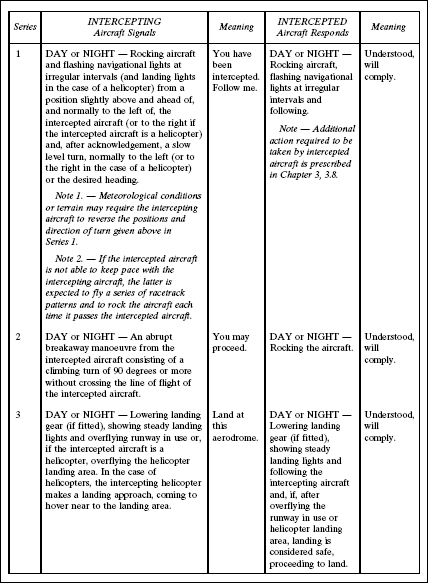 |
| 2.2 Signals initiated by intercepted aircraft and responses by intercepting aircraft |
|
|
| 3. VISUAL SIGNALS USED TO WARN AN UNAUTHORIZED AIRCRAFT FLYING IN, OR ABOUT TO ENTER A RESTRICTED, PROHIBITED OR DANGER AREA |
| | By day and by night, a series of projectiles discharged from the ground at intervals of 10 seconds, each showing, on bursting, red and green lights or stars will indicate to an unauthorized aircraft that it is flying in or about to enter a restricted, prohibited or danger area, and that the aircraft is to take such remedial action as may be necessary. |
| | 4. SIGNALS FOR AERODROME TRAFFIC |
| | 4.1 Light and pyrotechnic signals |
| |
|
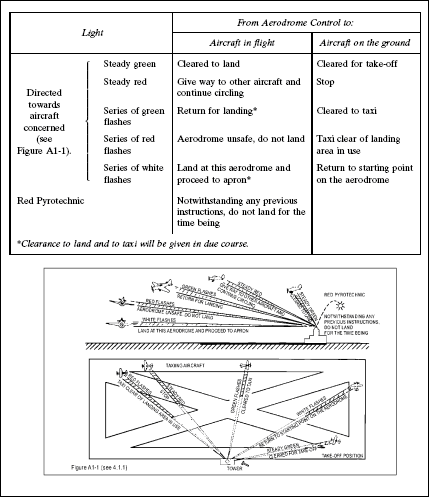 |
| 4.1.2 Acknowledgement by an aircraft |
| | | 1) | during the hours of daylight: |
|
| | — | by rocking the aircraft’s wings; |
|
| | 2) | during the hours of darkness: |
|
| | — | by flashing on and off twice the aircraft’s landing lights or, if not so equipped, by switching on and off twice its navigation lights. |
|
| | | 1) | during the hours of daylight: |
|
| | — | by moving the aircraft’s ailerons or rudder; |
|
| | 2) | during the hours of darkness: |
|
| | — | by flashing on and off twice the aircraft’s landing lights or, if not so equipped, by switching on and off twice its navigation lights. |
|
| | 4.2 Visual ground signals |
| | 4.2.1 Prohibition of landing |
| | A horizontal red square panel with yellow diagonals (Figure A1-2) when displayed in a signal area indicates that landings are prohibited and that the prohibition is liable to be prolonged. |
|
|
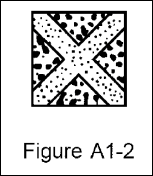 |
| 4.2.2 Need for special precautions while approaching or landing |
| | A horizontal red square panel with one yellow diagonal (Figure A1-3) when displayed in a signal area indicates that owing to the bad state of the manoeuvring area, or for any other reason, special precautions must be observed in approaching to land or in landing. |
|
|
| 4.2.3 Use of runways and taxiways |
| | 4.2.3.1 A horizontal white dumb-bell (Figure A1-4) when displayed in a signal area indicates that aircraft are required to land, take off and taxi on runways and taxiways only. |
|
|
| 4.2.3.2 The same horizontal white dumb-bell as in 4.2.3.1 but with a black bar placed perpendicular to the shaft across each circular portion of the dumb-bell (Figure A1-5) when displayed in a signal area indicates that aircraft are required to land and take off on runways only, but other manoeuvres need not be confined to runways and taxiways. |
|
|
| 4.2.4 Closed runways or taxiways |
| | Crosses of a single contrasting colour, yellow or white (Figure A1-6), displayed horizontally on runways and taxiways or parts thereof indicate an area unfit for movement of aircraft. |
|
|
| 4.2.5 Directions for landing or take-off |
| | 4.2.5.1 A horizontal white or orange landing T (Figure A1-7) indicates the direction to be used by aircraft for landing and take-off, which shall be in a direction parallel to the shaft of the T towards the cross arm. |
|
|
| 4.2.5.2 A set of two digits (Figure A1-8) displayed vertically at or near the aerodrome control tower indicates to aircraft on the manoeuvring area the direction for take-off, expressed in units of 10 degrees to the nearest 10 degrees of the magnetic compass. |
|
|
| | When displayed in a signal area, or horizontally at the end of the runway or strip in use, a right-hand arrow of conspicuous colour (Figure A1-9) indicates that turns are to be made to the right before landing and after take-off. |
|
|
| 4.2.7 Air traffic services reporting office |
| | The letter C displayed vertically in black against a yellow background (Figure A1-10) indicates the location of the air traffic services reporting office. |
|
|
| 4.2.8 Glider flights in operation |
| | A double white cross displayed horizontally (Figure A1-11) in the signal area indicates that the aerodrome is being used by gliders and that glider flights are being performed. |
|
|
| | 5.1 From a signalman to an aircraft |
| | 5.1.1 Prior to using the following signals, the signalman shall ascertain that the area within which an aircraft is to be guided is clear of objects which the aircraft, in complying with 3.4.1, might otherwise strike. |
|
|
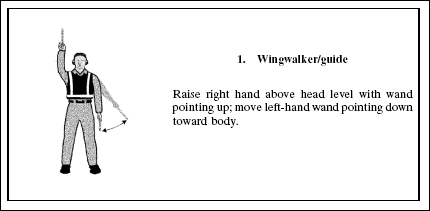 |
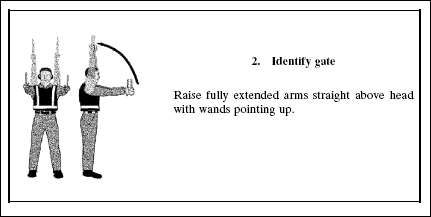 |
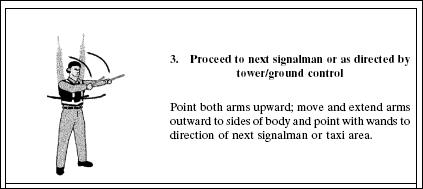 |
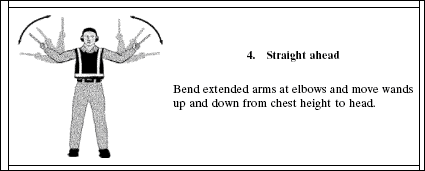 |
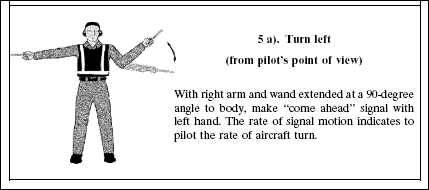 |
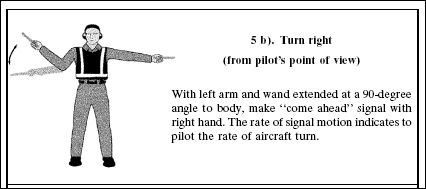 |
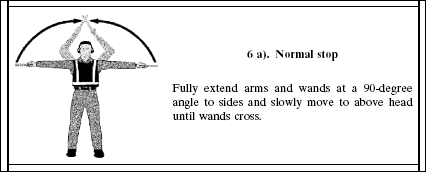 |
 |
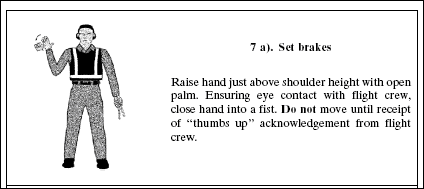 |
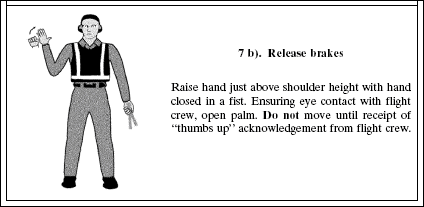 |
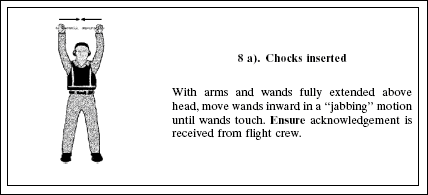 |
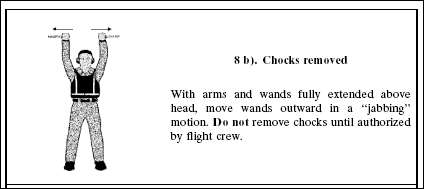 |
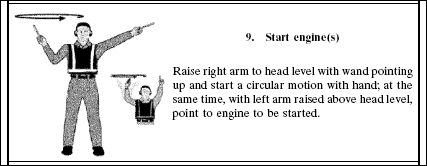 |
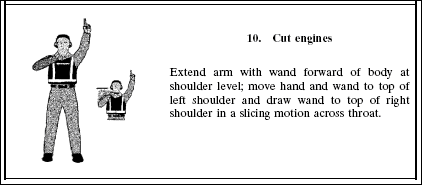 |
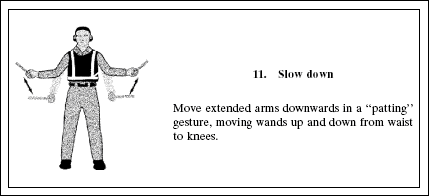 |
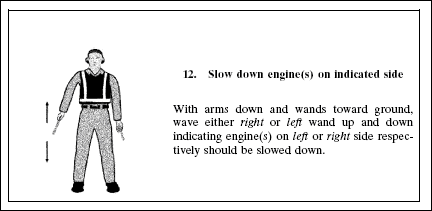 |
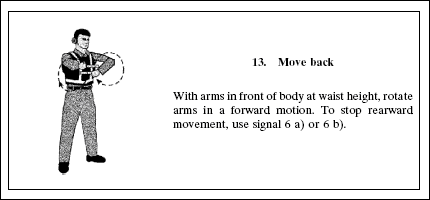 |
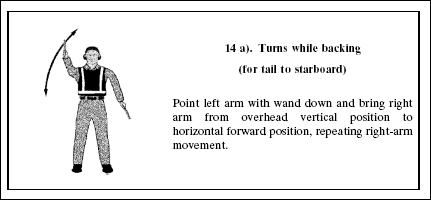 |
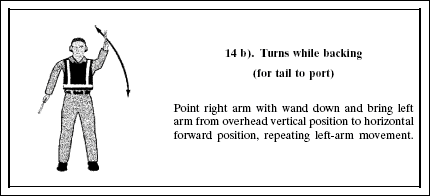 |
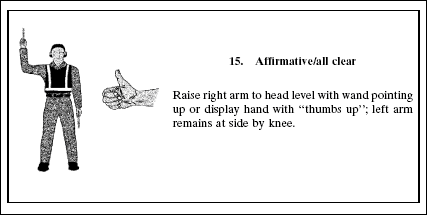 |
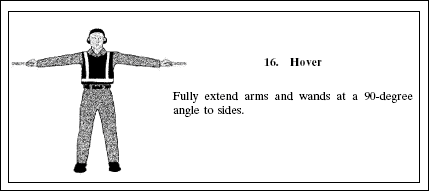 |
 |
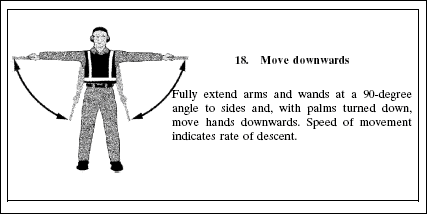 |
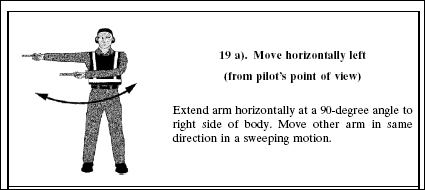 |
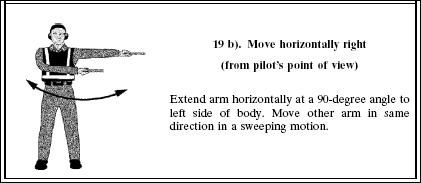 |
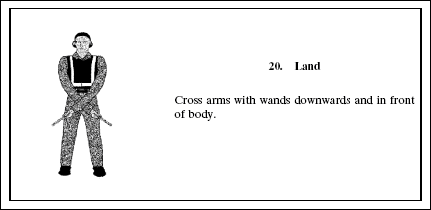 |
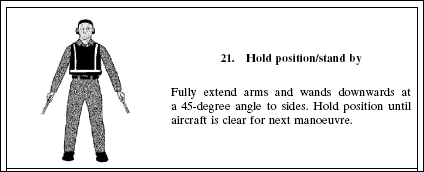 |
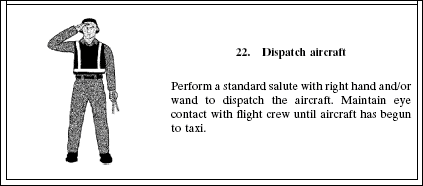 |
 |
 |
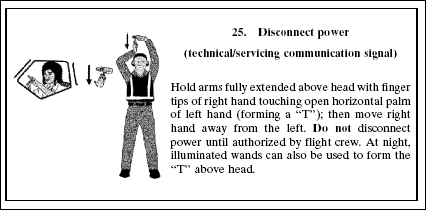 |
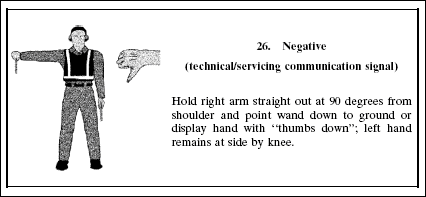 |
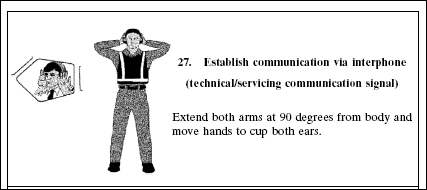 |
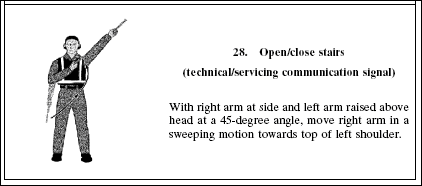 |
| 5.2 From the pilot of an aircraft to a signalman |
| | | a) | Brakes engaged: raise arm and hand, with fingers extended, horizontally in front of face, then clench fist. |
|
| b) | Brakes released: raise arm, with fist clenched, horizontally in front of face, then extend fingers. |
|
| | | a) | Insert chocks: arms extended, palms outwards, move hands inwards to cross in front of face. |
|
| b) | Remove chocks: hands crossed in front of face, palms outwards, move arms outwards. |
|
| | 5.2.3 Ready to start engine(s) |
| | Raise the appropriate number of fingers on one hand indicating the number of the engine to be started. |
| | 5.3 Technical/servicing communication signals |
| | 5.3.1 | Manual signals shall only be used when verbal communication is not possible with respect to technical/servicing communication signals. |
|
| 5.3.2 | Signalmen shall ensure that an acknowledgement is received from the flight crew with respect to technical/servicing communication signals. |
|
| | 6. STANDARD EMERGENCY HAND SIGNALS |
| | The following hand signals are established as the minimum required for emergency communication between the aircraft rescue and firefighting (ARFF) incident commander/ARFF firefighters and the cockpit and/or cabin crews of the incident aircraft. ARFF emergency hand signals should be given from the left front side of the aircraft for the flight crew. |
|
|
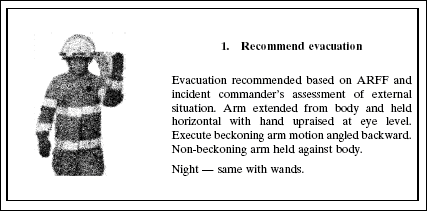 |
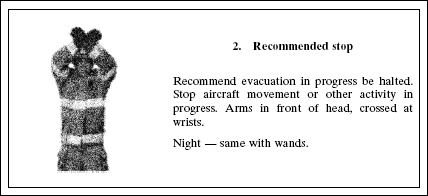 |
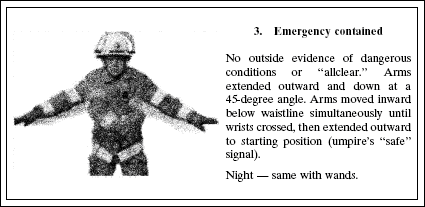 |
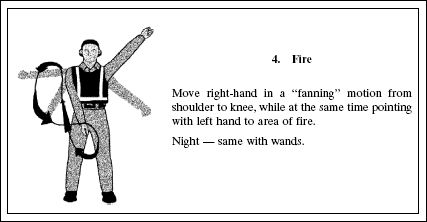 |
| APPENDIX 2. INTERCEPTION OF CIVIL AIRCRAFT |
| | 1. Principles to be observed by States |
| | 1.1 | To achieve the uniformity in regulations which is necessary for the safety of navigation of civil aircraft due regard shall be had by Contracting States to the following principles when developing regulations and administrative directives: |
|
| a) | interception of civil aircraft will be undertaken only as a last resort; |
|
| b) | if undertaken, an interception will be limited to determining the identity of the aircraft, unless it is necessary to return the aircraft to its planned track, direct it beyond the boundaries of national airspace, guide it away from a prohibited, restricted or danger area or instruct it to effect a landing at a designated aerodrome; |
|
| c) | practice interception of civil aircraft will not be undertaken; |
|
| d) | navigational guidance and related information will be given to an intercepted aircraft by radiotelephony, whenever radio contact can be established; and |
|
| e) | in the case where an intercepted civil aircraft is required to land in the territory overflown, the aerodrome designated for the landing is to be suitable for the safe landing of the aircraft type concerned. |
|
| 1.2 | Contracting States shall publish a standard method that has been established for the manoeuvring of aircraft intercepting a civil aircraft. Such method shall be designed to avoid any hazard for the intercepted aircraft. |
|
| 1.3 | Contracting States shall ensure that provision is made for the use of secondary surveillance radar or ADS-B, where available, to identify civil aircraft in areas where they may be subject to interception. |
|
| | 2. Action by intercepted aircraft |
| | 2.1 An aircraft which is intercepted by another aircraft shall immediately: |
| a) | follow the instructions given by the intercepting aircraft, interpreting and responding to visual signals in accordance with the specifications in Appendix 1; |
|
| b) | notify, if possible, the appropriate air traffic services unit; |
|
| c) | attempt to establish radiocommunication with the intercepting aircraft or with the appropriate intercept control unit, by making a general call on the emergency frequency 121.5 MHz, giving the identity of the intercepted aircraft and the nature of the flight; and if no contact has been established and if practicable, repeating this call on the emergency frequency 243 MHz; |
|
| d) | if equipped with SSR transponder, select Mode A, Code 7700, unless otherwise instructed by the appropriate air traffic services unit; |
|
| e) | if equipped with ADS-B or ADS-C, select the appropriate emergency functionality, if available, unless otherwise instructed by the appropriate air traffic services unit. |
|
| 2.2 | If any instructions received by radio from any sources conflict with those given by the intercepting aircraft by visual signals, the intercepted aircraft shall request immediate clarification while continuing to comply with the visual instructions given by the intercepting aircraft. |
|
| 2.3 | If any instructions received by radio from any sources conflict with those given by the intercepting aircraft by radio, the intercepted aircraft shall request immediate clarification while continuing to comply with the radio instructions given by the intercepting aircraft. |
|
| | 3. Radiocommunication during interception |
| | If radio contact is established during interception but communication in a common language is not possible, attempts shall be made to convey instructions, acknowledgement of instructions and essential information by using the phrases and pronunciations in Table A2-1 and transmitting each phrase twice: |
|
|
 |
| APPENDIX 3. TABLES OF CRUISING LEVELS |
| | The cruising levels to be observed when so required by this Annex are as follows: |
| | | a) | in areas where feet are used for altitude and where, in accordance with regional air navigation agreements, a vertical separation minimum of 1 000 ft is applied between FL 290 and FL 410 inclusive:* |
|
|
|
| | b) | in areas where metres are used for altitude and where, in accordance with regional air navigation agreements, a vertical separation minimum of 300 m is applied between 8 900 m and 12 500 m inclusive:* |
|
|
|
| | c) | in other areas where feet are the primary unit of measurement for altitude: |
|
|
|
| | d) | in other areas where metres are the primary unit of measurement for altitude: |
|
|
|
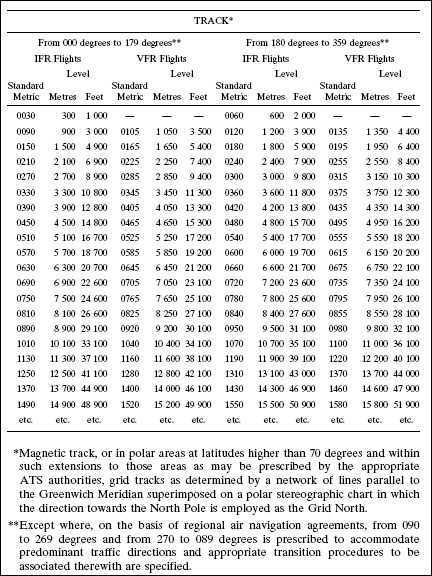 |
| APPENDIX 4. UNMANNED FREE BALLOONS |
| | 1. Classification of unmanned free balloons |
| | Unmanned free balloons shall be classified as: |
| a) | light: an unmanned free balloon which carries a payload of one or more packages with a combined mass of less than 4 kg, unless qualifying as a heavy balloon in accordance with c) 2), 3) or 4) below; or |
|
| b) | medium: an unmanned free balloon which carries a payload of two or more packages with a combined mass of 4 kg or more, but less than 6 kg, unless qualifying as a heavy balloon in accordance with c) 2), 3) or 4) below; or |
|
| c) | heavy: an unmanned free balloon which carries a payload which: |
|
| 1) | has a combined mass of 6 kg or more; or |
|
| 2) | includes a package of 3 kg or more; or |
|
| 3) | includes a package of 2 kg or more with an area density of more than 13 g per square centimetre; or |
|
| 4) | uses a rope or other device for suspension of the payload that requires an impact force of 230 N or more to separate the suspended payload from the balloon. |
|
| | 2. General operating rules |
| | 2.1 | An unmanned free balloon shall not be operated without appropriate authorization from the State from which the launch is made. |
|
| 2.2 | An unmanned free balloon, other than a light balloon used exclusively for meteorological purposes and operated in the manner prescribed by the appropriate authority, shall not be operated across the territory of another State without appropriate authorization from the other State concerned. |
|
| 2.3 | The authorization referred to in 2.2 shall be obtained prior to the launching of the balloon if there is reasonable expectation, when planning the operation, that the balloon may drift into airspace over the territory of another State. Such authorization may be obtained for a series of balloon flights or for a particular type of recurring flight, e.g. atmospheric research balloon flights. |
|
| 2.4 | An unmanned free balloon shall be operated in accordance with conditions specified by the State of Registry and the State(s) expected to be overflown. |
|
| 2.5 | An unmanned free balloon shall not be operated in such a manner that impact of the balloon, or any part thereof, including its payload, with the surface of the earth, creates a hazard to persons or property not associated with the operation. |
|
| 2.6 | A heavy unmanned free balloon shall not be operated over the high seas without prior coordination with the appropriate ATS authority. |
|
|
|
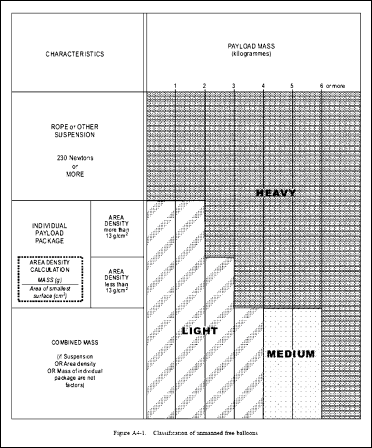 |
| 3. Operating limitations and equipment requirements |
| | 3.1 | A heavy unmanned free balloon shall not be operated without authorization from the appropriate ATS authority at or through any level below 18 000 m (60 000 ft) pressure-altitude at which: |
|
| a) | there are clouds or obscuring phenomena of more than four oktas coverage; or |
|
| b) | the horizontal visibility is less than 8 km. |
|
| 3.2 | A heavy or medium unmanned free balloon shall not be released in a manner that will cause it to fly lower than 300 m (1 000 ft) over the congested areas of cities, towns or settlements or an open-air assembly of persons not associated with the operation. |
|
| 3.3 | A heavy unmanned free balloon shall not be operated unless: |
|
| a) | it is equipped with at least two payload flight termination devices or systems, whether automatic or operated by telecommand, that operate independently of each other; |
|
| b) | for polyethylene zero-pressure balloons, at least two methods, systems, devices, or combinations thereof, that function independently of each other are employed for terminating the flight of the balloon envelope; |
|
| c) | the balloon envelope is equipped with either a radar reflective device(s) or radar reflective material that will present an echo to surface radar operating in the 200 MHz to 2 700 MHz frequency range, and/or the balloon is equipped with such other devices as will permit continuous tracking by the operator beyond the range of ground-based radar. |
|
| 3.4 | A heavy unmanned free balloon shall not be operated under the following conditions: |
|
| a) | in an area where ground-based SSR equipment is in use, unless it is equipped with a secondary surveillance radar transponder, with pressure-altitude reporting capability, which is continuously operating on an assigned code, or which can be turned on when necessary by the tracking station; or |
|
| b) | in an area where ground-based ADS-B equipment is in use, unless it is equipped with an ADS-B transmitter, with pressure-altitude reporting capability, which is continuously operating or which can be turned on when necessary by the tracking station. |
|
| 3.5 | An unmanned free balloon that is equipped with a trailing antenna that requires a force of more than 230 N to break it at any point shall not be operated unless the antenna has coloured pennants or streamers that are attached at not more than 15 m intervals. |
|
| 3.6 | A heavy unmanned free balloon shall not be operated below 18 000 m (60 000 ft) pressure-altitude between sunset and sunrise or such other period between sunset and sunrise (corrected to the altitude of operation) as may be prescribed by the appropriate ATS authority, unless the balloon and its attachments and payload, whether or not they become separated during the operation, are lighted. |
|
| 3.7 | A heavy unmanned free balloon that is equipped with a suspension device (other than a highly conspicuously coloured open parachute) more than 15 m long shall not be operated between sunrise and sunset below 18 000 m (60 000 ft) pressure-altitude unless the suspension device is coloured in alternate bands of high conspicuity colours or has coloured pennants attached. |
|
| | | The operator of a heavy unmanned free balloon shall activate the appropriate termination devices required by 3.3 a) and b) above: |
| a) | when it becomes known that weather conditions are less than those prescribed for the operation; |
|
| b) | if a malfunction or any other reason makes further operation hazardous to air traffic or to persons or property on the surface; or |
|
| c) | prior to unauthorized entry into the airspace over another State’s territory. |
|
| | | 5.1 Pre-flight notification |
| | 5.1.1 | Early notification of the intended flight of an unmanned free balloon in the medium or heavy category shall be made to the appropriate air traffic services unit not less than seven days before the date of the intended flight. |
|
| 5.1.2 | Notification of the intended flight shall include such of the following information as may be required by the appropriate air traffic services unit: |
|
| a) | balloon flight identification or project code name; |
|
| b) | balloon classification and description; |
|
| c) | SSR code, aircraft address or NDB frequency as applicable; |
|
| d) | operator’s name and telephone number; |
|
| f) | estimated time of launch (or time of commencement and completion of multiple launches); |
|
| g) | number of balloons to be launched and the scheduled interval between launches (if multiple launches); |
|
| h) | expected direction of ascent; |
|
| i) | cruising level(s) (pressure-altitude); |
|
| j) | the estimated elapsed time to pass 18 000 m (60 000 ft) pressure-altitude or to reach cruising level if at or below 18 000 m (60 000 ft), together with the estimated location; |
|
| k) | the estimated date and time of termination of the flight and the planned location of the impact/recovery area. In the case of balloons carrying out flights of long duration, as a result of which the date and time of termination of the flight and the location of impact cannot be forecast with accuracy, the term "long duration" shall be used. |
|
| 5.1.3 | Any changes in the pre-launch information notified in accordance with 5.1.2 above shall be forwarded to the air traffic services unit concerned not less than 6 hours before the estimated time of launch, or in the case of solar or cosmic disturbance investigations involving a critical time element, not less than 30 minutes before the estimated time of the commencement of the operation. |
|
| | 5.2 Notification of launch |
| | Immediately after a medium or heavy unmanned free balloon is launched the operator shall notify the appropriate air traffic services unit of the following: |
| a) | balloon flight identification; |
|
| d) | estimated time at which 18 000 m (60 000 ft) pressure-altitude will be passed, or the estimated time at which the cruising level will be reached if at or below 18 000 m (60 000 ft), and the estimated location; and |
|
| e) | any changes to the information previously notified in accordance with 5.1.2 g) and h). |
|
| | 5.3 Notification of cancellation |
| | The operator shall notify the appropriate air traffic services unit immediately it is known that the intended flight of a medium or heavy unmanned free balloon, previously notified in accordance with 5.1, has been cancelled. |
| | 6. Position recording and reports |
| | 6.1 | The operator of a heavy unmanned free balloon operating at or below 18 000 m (60 000 ft) pressure-altitude shall monitor the flight path of the balloon and forward reports of the balloon’s position as requested by air traffic services. Unless air traffic services require reports of the balloon’s position at more frequent intervals, the operator shall record the position every 2 hours. |
|
| 6.2 | The operator of a heavy unmanned free balloon operating above 18 000 m (60 000 ft) pressure-altitude shall monitor the flight progress of the balloon and forward reports of the balloon’s position as requested by air traffic services. Unless air traffic services require reports of the balloon’s position at more frequent intervals, the operator shall record the position every 24 hours. |
|
| 6.3 | If a position cannot be recorded in accordance with 6.1 and 6.2, the operator shall immediately notify the appropriate air traffic services unit. This notification shall include the last recorded position. The appropriate air traffic services unit shall be notified immediately when tracking of the balloon is re-established. |
|
| 6.4 | One hour before the beginning of planned descent of a heavy unmanned free balloon, the operator shall forward to the appropriate ATS unit the following information regarding the balloon: |
|
| a) | the current geographical position; |
|
| b) | the current level (pressure-altitude); |
|
| c) | the forecast time of penetration of 18 000 m (60 000 ft) pressure-altitude, if applicable; |
|
| d) | the forecast time and location of ground impact. |
|
| 6.5 | The operator of a heavy or medium unmanned free balloon shall notify the appropriate air traffic services unit when the operation is ended. |
|
| | | | Definitions for this Part |
| 1.1 The terms used in this Part shall have the same meanings as the same terms defined in Chapter 1 of Part I. |
| (a) | For the purpose of this Part, the horizontal plane of a light shown by an aircraft means the plane which would be the horizontal plane passing through the source of that light, if the aircraft were in level flight. |
|
| (b) | Where by reason of the physical construction of an aircraft it is necessary to fit more than one lamp in order to show a light required by this Part, the lamps shall be so fitted and constructed that, so far as is reasonably practicable, not more than one such lamp is visible from any one point outside the aircraft. |
|
| (c) | Where in this Part a light is required to show through specified angles in the horizontal plane, the lamps giving such light shall be so constructed and fitted that the light is visible from any point in any vertical plane within those angles throughout angles of 90° above and below the horizontal plane, but, so far as is reasonably practicable, through no greater angle, either in the horizontal plane or the vertical plane. |
|
| (d) | Where in this Part a light is required to show in all directions the lamps giving such light shall be so constructed and fitted that, so far as is reasonably practicable, the light is visible from any point in the horizontal plane and on any vertical plane passing through the source of that light. |
|
| Meaning of Standard Atmosphere |
| 2. For the purpose of the definition of “pressure-altitude” in Chapter 1 of Part I, “Standard atmosphere” means an atmosphere defined as follows: |
|
|
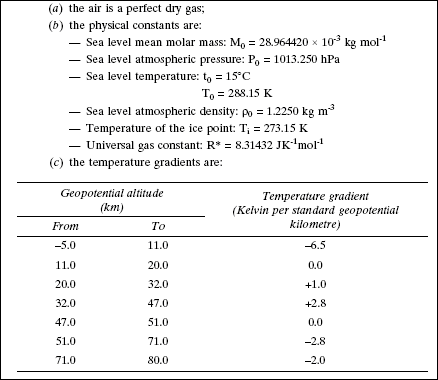 |
| Reporting Hazardous Conditions |
| 3. The pilot-in-command of an aircraft shall, on meeting with hazardous conditions in the course of a flight, or as soon as possible thereafter, send to the appropriate air traffic control unit by the quickest means available information containing such particulars of the hazardous conditions as may be pertinent to the safety of other aircraft. |
| Practice Instrument Approaches |
| 4. Within Singapore, an aircraft shall not carry out instrument approach practice when flying in Visual Meteorological Conditions unless — |
| (a) | the appropriate air traffic control unit has previously been informed that the flight is to be made for the purpose of instrument approach practice; and |
|
| (b) | if the flight is not being carried out in simulated instrument flight conditions, an observer approved by the Chief Executive is carried in such a position in the aircraft that he has an adequate field of vision and can readily communicate with the pilot flying the aircraft. |
|
| Failure of Navigation Lights |
| 5. In Singapore, in the event of the failure of any light which is required by this Part to be displayed in flight, if the light cannot be immediately repaired or replaced the aircraft shall land as soon as in the opinion of the pilot-in-command of the aircraft it can safely do so, unless authorised by the appropriate air traffic control unit to continue its flight. |
| 6.1 A flying machine when flying at night shall display lights as follows: |
| (a) | in the case of a flying machine registered in Singapore having a maximum total weight authorised of more than 5,700 kg, it shall display the system of lights specified in 6.2(b); |
|
| (b) | in the case of a flying machine registered in Singapore having a maximum total weight authorised of 5,700 kg or less, any one of the following systems of lights — |
|
| (i) | that specified in 6.2(a); |
|
| (ii) | that specified in 6.2(b); or |
|
| (iii) | that specified in 6.2(d) excluding 6.2(d)(ii); and |
|
| (c) | in the case of any other flying machine one of the systems of lights specified in 6.2. |
|
| 6.2 The systems of lights referred to in 6.1 are as follows: |
| (a) | (i) a green light of at least 5 candela showing to the starboard side through an angle of 110° from dead ahead in the horizontal plane; |
|
| (ii) a red light of at least 5 candela showing to the port side through an angle of 110° from dead ahead in the horizontal plane; and |
| (iii) a white light of at least 3 candela showing through angles of 70° from dead astern to each side in the horizontal plane, all being steady lights; |
| (b) | (i) the lights specified in (a); and |
|
| (ii) an anti-collision light; |
| (c) | the lights specified in (a), but all being flashing lights flashing together; and |
|
| (d) | the lights specified in (a), but all being flashing lights flashing together in alternation with one or both of the following: |
|
| (i) A flashing white light of at least 20 candela showing in all directions; |
| (ii) a flashing red light of at least 20 candela showing through angles of 70° from dead astern to each side in the horizontal plane. |
| 6.3 If the lamp showing either the red or the green light specified in 6.2(a) is fitted more than two metres from the wing tip, a lamp may, notwithstanding 3.2.3.1 of Part I, be fitted at the wing tip to indicate its position, showing a steady light of the same colour through the same angle. |
| 7. A glider while flying at night shall display either a steady red light of at least 5 candela showing in all directions, or lights in accordance with 6.2 and 6.3 of this Part. |
| 8. A free balloon while flying at night shall display a steady red light, of at least 5 candela, showing in all directions, suspended not less than 5 metres and not more than 10 metres below the basket, or if there is no basket, below the lowest part of the balloon. |
| Captive Balloons and Kites |
| 9.1 A captive balloon or kite while flying at night at a height exceeding 60 metres above the surface shall display lights as follows: |
| (a) | a group of two steady lights consisting of a white light placed 4 metres above a red light, both being of at least 5 candela and showing in all directions, the white light being placed not less than 5 metres or more than 10 metres below the basket, or, if there is no basket, below the lowest part of the balloon or kite; |
|
| (b) | on the mooring cable, at intervals of not more than 300 metres measured from the group of lights referred to in (a), groups of lights of the colour and power and in the relative position specified in that sub-paragraph, and, if the lowest group of lights is obscured by cloud, an additional group below the cloud base; and |
|
| (c) | on the surface, a group of 3 flashing lights arranged in a horizontal plane at the apexes of a triangle, approximately equilateral, each side of which measures at least 25 metres; one side of the triangle shall be approximately at right angles to the horizontal projection of the cable and shall be delimited by two red lights; the third light shall be a green light so placed that the triangle encloses the object on the surface to which the balloon or kite is moored. |
|
| 9.2 A captive balloon while flying by day at a height exceeding 60 metres above the surface shall have attached to its mooring cable at intervals of not more than 200 metres measured from the basket, or, if there is no basket, from the lowest part of the balloon, tubular streamers not less than 40 cm in diameter and two metres in length, and marked with alternate bands of red and white 50 cm wide. |
| 9.3 A kite flown in the circumstances referred to in 9.2 shall have attached to its mooring cable either — |
| (a) | tubular streamers as specified in 9.2; or |
|
| (b) | at intervals of not more than 100 metres measured from the lowest part of the kite, streamers of not less than 80 cm long and 30 cm wide at their widest part and marked with alternate bands of red and white 10 cm wide. |
|
| 10.1 Except as provided in 10.2, an airship while flying at night shall display the following steady lights: |
| (a) | a white light of at least 5 candela showing through angles of 110° from dead ahead to each side in the horizontal plane; |
|
| (b) | a green light of at least 5 candela showing to the starboard side through an angle of 110° from dead ahead in the horizontal plane; |
|
| (c) | a red light of at least 5 candela showing to the port side through an angle of 110° from dead ahead in the horizontal plane; and |
|
| (d) | a white light of at least 5 candela showing through angles of 70° from dead astern to each side in the horizontal plane. |
|
| 10.2 An airship while flying at night shall display, if it is not under command, or has voluntarily stopped its engines, or is being towed, the following steady lights: |
| (a) | the white lights referred to in 10.1(a) and (d); |
|
| (b) | two red lights, each of at least 5 candela and showing in all directions suspended below the control car so that one is at least 4 metres above the other and at least 8 metres below the control car; and |
|
| (c) | if the airship is making way but not otherwise, the green and red lights referred to in 10.1(b) and (c): |
|
| Provided that an airship while picking up its moorings, notwithstanding that it is not under command, shall display only the lights specified in 10.1. |
| 10.3 An airship, while moored within Singapore by night, shall display the following lights: |
| (a) | when moored to a mooring mast, at or near the rear a white light of at least 5 candela showing in all directions; |
|
| (b) | when moored otherwise than to a mooring mast — |
|
| (i) | a white light of at least 5 candela showing through angles of 110° from dead ahead to each side in the horizontal plane; and |
|
| (ii) | a white light of at least 5 candela showing through angles of 70° from dead astern to each side in the horizontal plane. |
|
| 10.4 An airship while flying by day, if it is not under command, or has voluntarily stopped its engines, or is being towed, shall display two black balls suspended below the control car so that one is at least 4 metres above the other and at least 8 metres below the control car. |
| 10.5 For the purpose of 10.1 to 10.4 — |
| (a) | an airship shall be deemed not to be under command when it is unable to execute a manoeuvre which it may be required to execute by or under this Part; and |
|
| (b) | an airship shall be deemed to be making way when it is not moored and is in motion relative to the air. |
|
| Weather Reports and Forecasts |
| 11.1 Immediately before an aircraft flies the pilot-in-command of the aircraft shall examine the current reports and forecasts of the weather conditions on the proposed flight path, being reports and forecasts which it is reasonably practicable for him to obtain in order to determine whether Instrument Meteorological Conditions prevail or are likely to prevail during any part of the flight. |
| 11.2 An aircraft which is unable to communicate by radio with an air traffic control unit at the aerodrome of destination shall not begin a flight to an aerodrome within a control zone if the information which it is reasonably practicable for the pilot-in-command of the aircraft to obtain indicates that it will arrive at that aerodrome when the ground visibility is less than 8 km or the cloud ceiling is less than 1,500 feet, unless the pilot-in-command of the aircraft has obtained from an air traffic control unit at that aerodrome permission to enter the aerodrome traffic zone. |
| 12. An aircraft which is flying within Singapore in sight of the ground and following a road, railway, canal or coastline, or any other line of landmarks, shall keep such line of landmarks on its left. |
| 13. The pilot-in-command of an aeroplane on, or in the traffic zone of an aerodrome shall observe such visual signals as may be displayed at, or directed to him from, the aerodrome by the authority of the person in charge of the aerodrome and shall obey any instruction which may be given to him by means of such signals: |
| Provided that he shall not be required to obey the signals referred to in rule 5.1 of Appendix 1 of Part I if in his opinion it is inadvisable to do so in the interests of safety. |
| Dropping of Tow Ropes, etc. |
| 14. Tow ropes, banners or similar articles towed by aircraft shall not be dropped from aircraft except at an aerodrome and — |
| (a) | in accordance with arrangements made with an air traffic control unit at the aerodrome and with the aerodrome operator; and |
|
| (b) | in the area designated by a yellow cross with two arms 6 metres long by 1 metre wide at right angles and when the aircraft is flying in the direction appropriate for landing. |
|
| Special Rules for Certain Aerodromes |
| 15. The Chief Executive may make special rules for the operation of aircraft in the vicinity of notified aerodromes. Such special rules unless expressly stated otherwise, shall apply in addition to the other rules in this Schedule. |
|
|
|
|
|



